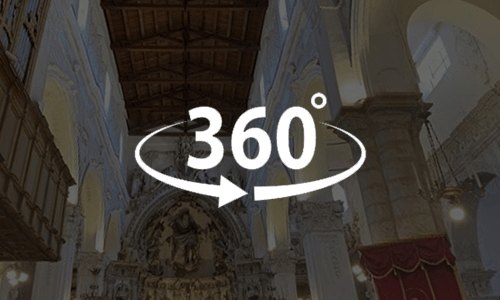Dedicated to Saint Mary Magdalene, the church already existed in 1230. It became a parish seat in 1494. It preserves the plan-volumetric layout of the 15th-16th century reconstruction. The façade combines Gothic elements (pilasters, portal, rose window) and Baroque elements attributable to the interventions (1694-1702) directed by G.B. Mansella, cousin and student of Paolo Amato
On the right side of the entrance door, we find the “Baptismal font” in stone and marble from the 17th century, next to a painting of “San Benedetto in gloria” by the painter Filippo Randazzo, then a painting by the painter Vincenzo La Barbera “DormitioVirginis” from 1608; going up towards the altar we find the Chapel dedicated to Sant’Andrea, a sculpture by Filippo Quattrocchi from 1796, inside there is a canvas depicting “Lo Spasimo” oil on canvas from the 16th century, the work of the Dutch painter Simone Wobreck; a painting of “Santa Maria Maddalena” by an unknown painter from the 17th century and two tombs on the sides in marble of the noble Barons of Ciminna.
Continuing the visit we find another chapel dedicated to the S.S. Crucifix, former Chapel of Saints Simon and Thaddeus, from 1531. In it we find a “Wooden Crucifix” from the 17th century, a painting depicting the “Apostles Simon and Thaddeus” by the painter Melchiorre Di Bella from the 18th century, a painting depicting “Saint Rosalia” by the painter Geronimo De Gerardi from 1625, a statue depicting “Saint Michael the Archangel” and another depicting “Saint Rocco” by the sculptor Bagnasco and finally a wooden work created by the sculptor Giuseppe D’Angelo from Monte Erice
Looking ahead, you can see the Chapel of the Blessed Sacrament with a silver altar, made in 1794 by the silversmiths of Palermo. A pencil and pastel canvas representing “The Last Supper” by Melchiorre Di Bella and a painting depicting the “Martyrdom of the Ten Thousand” from the 17th century. In the Next door, you enter in the New Sacristy, where you can see a marble triptych from the Gagini school, many paintings all oil on canvas depicting the Archpriests who succeeded each other, a sedan chair from the 18th century, as well as beautiful sacred vestments dating from the 17th to the 18th century.
And finally, an oil on canvas painting representing “l’Adorazione del S.S. Nome di Gesù” by the Monrealese painter Pietro Novelli. Returning to pass through the left aisle, we find ourselves in front of two sublime works of art: the “Choir” and the “Main Altar”. The carved wooden Choir is the work of the famous carver from Palermo Giuseppe Dattolino, created in 1619, while the High Altar is the magnum opus of the Li Vorsi brothers from Tusa. It is divided into sections: one part represents the “Church militant on earth”, with the statues dedicated to the Apostles and with Mary Magdalene in the centre, titular of the Church, the “Apostola Apostolorum” who was the first to announce the resurrection of Jesus to the Apostles. The upper part represents the Church triumphant in heaven with the statues of the Evangelists and above them in the centre the effigy of the Eternal Father who stands over the celestial sphere with his foot to symbolise the dominion of the universe, with a host of Angels and Seraphim next to him who sing and play instruments of the time. The upper part of the basin ends with the statues of Saint Peter and Paul as points of connection between the earth and the sky. In the upper part again the figure of Eve and on the right that of Adam.
Moving into the left nave, we can observe the “Papal Throne” near the choir, used whenever the Pope visits Sicily; followed by the Chapel dedicated to the “Madonna dei liberi infermi” with a “Madonna col bambino” in the center, in marble created by the sculptor from Palermo Vincenzo Guercio in 1612, while the painting depicting San Gregorio was created by the painter Francesco Gigante from Ciminna in the 17th century. Next to it is a painting depicting the Immaculate Conception from the 18th century; close by is the chapel dedicated to Santa Rosalia and in it are: a polyptych, oil on panel attributed to the painter Nicolò da Pettineo from the mid-15th century, coming from the Church of Purgatory, a painted and gilded wooden statue depicting San Pietro from the 17th century, an oil painting on canvas depicting “Gli Agonizzanti” from the 16th century, and finally a stucco bust of the Prince of Ciminna Guglielmo Graffeo from the 18th century.
On the side of the Chapel, at the top you can see a very valuable pipe organ in perfect working order, work of Maestro Raffaele Della Valle from Palermo. The stage and the gilded upper part were made by Maestro Francesco Barberi in 1604. Next to the organ you can see a painting depicting the “Madonna del fervore” from the 19th century, followed by another painting depicting “Sant’Agnese” from the 18th century and finally a last painting depicting “The donation of the keys from Jesus to St. Peter” by the painter Vincenzo La Barbera from 1629. Before leaving the temple, you can see the “Cilio di Sant’Antonio Abate” a work in painted and gilded wood by a sculptor from Ciminna from the 17th century.
In the sacristy there is a collection of portraits, some made by P. Pasquale Sarullo from Ciminna. In 1962 it was the location of some filming of the masterpiece film by L. Visconti “IL GATTOPARDO (THE LEOPARD)”


